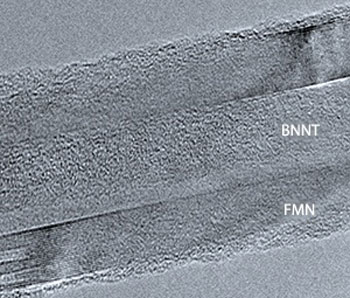| Jun 20, 2011 |
Boron nitride nanotubes could form the basis for fluorescent cell sensors
|
|
(Nanowerk News) Hollow nanotubes with walls just a few atoms thick are increasingly being used to monitor biological processes in individual cells. Such nanotubes can be loaded with fluorescent molecules that respond to certain biochemicals or a change in temperature or pH with a measurable change in fluorescence.
|
|
Most of the biological probes developed so far rely on carbon nanotubes. Now, a research team from Japan has now produced a probe using nanotubes made of boron and nitrogen atoms ("Noncovalent Functionalization of Disentangled Boron Nitride Nanotubes with Flavin Mononucleotides for Strong and Stable Visible-Light Emission in Aqueous Solution"). These boron nitride nanotubes (BNNTs) have a similar structure to their carbon cousins but are more chemically and thermally stable. BNNTs also tend to be less toxic to cells.
|
 |
| Transmission electron microscopy image of the FMN/BNNT hybrid probe. The central nanotube is ∼25 nm wide.
|
|
Takeshi Serizawa of the University of Tokyo and colleagues from the National Institute for Materials Science in Tsukuba loaded BNNTs with flavin mononucleotide (FMN), a derivative of vitamin B2 that has numerous biochemical roles. Mixing the FMN molecules with the BNNTs in water, and using ultrasound to shake them up, resulted in a yellow-orange hybrid that fluoresced bright green under ultraviolet light. This fluorescence decreased only slightly over time, suggesting that the hybrid was essentially stable in air.
|
|
Studying the FMN/BNNT hybrid using atomic force microscopy and electron microscopy revealed that the nanotubes were less than 80 nm wide but up to 8 µm long and covered with the FMN, which formed an amorphous-like outer coating (see image).
|
|
The team then investigated how the hybrid behaved at different pH levels. Under the mild conditions typically found in a cell (pH 5.5–8.2), there was little change in the intensity of the hybrid's fluorescence. But under more acidic conditions, the FMN molecules acquired a positive charge that broke their bonds with the BNNTs. This allowed the BNNTs to form bundles that reduced the intensity of the probe's fluorescence. Under more alkaline conditions, the FMN developed a negative charge that caused the same drop in fluorescence.
|
|
The scientists suggest that the hybrids could be used as the basis to build probes that are able to monitor biological processes without being affected by small pH changes inside a cell. They now aim to test the biocompatibility of the probe inside cells.
|

